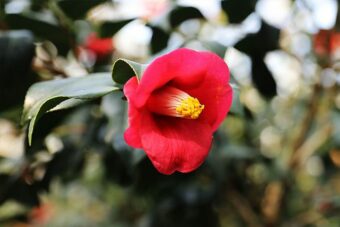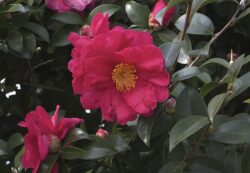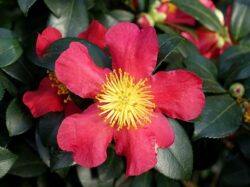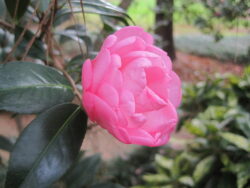In this article, we will discover how to grow the beautiful flowering shrub of Camellia in containers. Camellia, some experts consider it to be the queen of all flowering shrubs, because of the display of flowers it produces. Camellia is a large genus of flowering shrubs where 220 species are described (the exact number is hotly contested) and 3000 hybrids are known, belonging to the Theaceae (the tea) family.

Camellia is found naturally growing all over Eastern and South Asia, especially from the Himalayas to Japan and Indonesia. It gets its name after the Botanist and Jesuit priest Georg Joseph Kermel, who whilst working in the Philippines described several species.
Most of the common species are based on Camellia japonica or Camellia sansaqua or the hybrids of the two. Camellias are evergreen shrubs that can grow up to 20m tall. They tend to have glossy green leaves that are alternatively arranged and are often serrated. Plain whilst not in flower, but when the large flowers, up to 12cm in diameter appear, then it is another story, Each flower can be white, pink, red, or even yellow but this is only found in species grown in South China and Vietnam. The flowers may be single, semi-double, double, anemone or peony-like.
The species and varieties that are used to make teas, always produce later flowers. The flowers are followed by dry capsules containing up to 5 compartments, where each compartment can contain up to 8 seeds.
One thing that must be considered is that certain species and varieties are fast-growing, up to 30cm a year, whilst others are slow growing.
GROWING CAMELLIAS IN CONTAINERS
Camellias need two things to succeed- acidic soil and it must be grown in partial shade. This is why if you cannot meet these growing conditions then it is best to grow in containers.
First, choose a container that is at least 45cm wide and has plenty of drainage holes at the bottom. A large container is advised especially if you grow larger specimens.

To the bottom of this container add a 2cm layer of gravel to aid drainage further. On top of this add up to 5cm below the top rim with a good quality ericaceous compost. Dig a large hole in the centre of the container slightly larger than the root ball it came in the original container you bought it in.
Backfill with the growing media, checking so that no gaps or vacant spaces remain. If you find any you can fill it by using more ericaceous compost. Firm the shrub in and water very well.
As Camellias are slow growing in pots, you will not need to pot on frequently but only when the shrub has become root bound.
THE BEST GROWING CONDITIONS
As said previously it prefers to be grown in light shade, as icy winds and early morning sun, along with frosts and quick thawing, can damage spring flower buds.
You will need to water frequently until the shrub is established, which means watering with rainwater as soon as the surface feels dry to the touch. After that, you can water when 5cm below the top surface of the compost feels dry to the touch. Again water with rainwater until it emerges from the drainage holes.
You can add an annual dressing of slow-release, ericaceous fertilizer at the manufacturer’s recommended dosage to give enough nutrients to last through the growing season. At the same time, you can give a dressing of phosphate of iron to combat any chlorosis/yellowing of the leaves. Follow the instructions written on the packaging.

Pruning is very simple, as you do not need to do any. This can grow up to 5m if left unpruned but you cut back after flowering to keep it compact and in shape. You can remove all weak, damaged and unwanted branches in May.
If snow is forecasted, which can damage flower buds, it is better to move your container until the protection of a greenhouse.
To propagate you can layer shoots in autumn, or plant semi-ripe cuttings in a cold frame in summer. You can also take hardwood cuttings in the open in autumn to create new plants.
PESTS AND DISEASES
Flower buds can brown and drop in frosty weather or if it is snowing, once the morning sun shines upon them. To prevent this, you can cover that whole plant with a thick horticultural fleece or move it to the protection of a greenhouse. Direct sun can dry buds and prevent them from opening,
Brown patches on Camelia flower petals are caused by a fungus, Caberinia camelliae, the Camellia flower blight. It looks like frost damage but the flowers will start to turn brown and fall prematurely. Remove any flowers that show this to prevent future infestation.
As said earlier yellowing leaves mean that the plant is not getting enough Iron. As said before if this occurs you can feed with a liquid, ericaceous fertilizer to which a handful of sulphate of iron has been added to the compost.
Sooty moulds can occur if scale insects have attacked the plant. Use an insecticidal soap suitable for ornamental plants. This will kill the insects and you can wipe the mould off. If they do not flower it would mean that the plant will need feeding.
VARIETIES TO GROW

As you can imagine, there are thousands of hybrids and varieties that you can buy.
Most camellias are based on camellia japonica and will grow up to 3m tall. They can be kept in check by pruning as suggested earlier. The following are recommended:
‘Bonomiana’ produces pink flowers.
’Blooming Wonder’ with white or red flowers.
‘1001 Summer Nights’ Jasmine’ with single, red flowers.
‘Silvery Anniversary’ has white, double flowers.
‘Tricolour’ produces red, pink and white flowers on the same shrub.
‘Doctor King’ produces semi-double, red flowers.
‘Night Riders’ only grows up to 1.2m tall and has dark, red blooms. Some will say the darkest of all camellias.
‘High Fragrance’ has light pink, double flowers.
‘Roger Hall’ produces double, red flowers.
‘Mrs Swan’ only grows up to 2m tall and has light pink, semi-double flowers.
‘Swan Lake’ has double, pure white flowers.
An alternative is to grow the good–looking Camellia williamsii, which is taller and the only suitable one to grow in containers is ‘Ruby Wedding’. This produces large red flowers.
CONCLUSIONS
In this article, we have discussed how to grow the beautiful flowering shrub of Camellia in containers. As you can imagine they are easy to care for, easy to look after and you have many varieties and hybrids that can be grown. If you want a plant with plenty of blooms in early spring, then Camellias are for you.
If you have any questions or comments that you want to make on growing Camellia in containers, please do so in the comment box below.
Happy Camellia growing.
